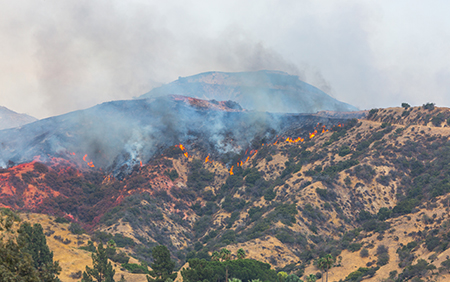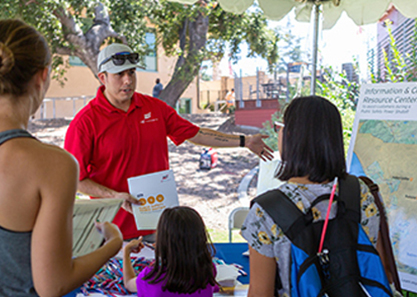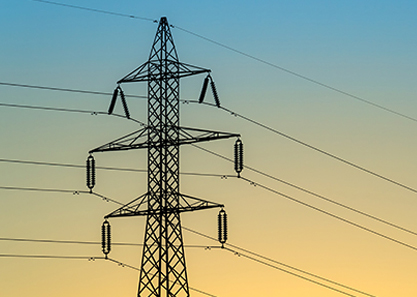Public Safety Power Shutoffs
During adverse weather conditions, a Public Safety Power Shutoff (PSPS) may be used to help prevent potential wildfires to help protect the communities we serve.
View and download our 2025 Wildfire Safety Newsletter here.
Get alerts
In the event of a Public Safety Power Shutoff, do we have your current contact information? Have you signed up for outage notifications?
What is a Public Safety Power Shutoff (PSPS)?
At SDG&E, safety is our top priority. As California’s climate has changed, the idea of a fire “season” has evolved into a year-round battle against stronger, faster wildfires. SDG&E has spent more than a decade building out a wildfire safety program that includes:
- Strengthening our electric infrastructure for the safety of our local communities
-
Creating a fire science and meteorology department to forecast and prepare for wildfires
-
Implementing innovative technology like our weather stations, camera network, drones and fire prediction modeling to watch for potential threats
Despite our substantial investments to reduce wildfire risks, there may still be times when we must shut off power to our electric circuits. If high-fire-risk conditions are present, we may shut off power to keep you and your community safe - this is called a Public Safety Power Shutoff (PSPS). This precaution helps prevent flying debris from coming into contact with power lines and potentially igniting a fire.

Public Safety Power Shutoff Process
7-10 days ahead
When forecasts show the potential for dangerous conditions, SDG&E monitors the fire risk and potential impacts.
3-6 days ahead
SDG&E refines weather forecast and wildfire potential accordingly.
2 days ahead
SDG&E will start notifying customers who could be affected by a possible PSPS, including critical facilities and medical baseline customers, as well as state, county and city government agencies.
1 day ahead
SDG&E continues to monitor weather conditions, communicate with affected communities and coordinate with first responders and public safety agencies.
Day of power shutoff
SDG&E notifies affected communities, and government and public safety agencies that power has been shut off.
Power restored
Once weather conditions are safe, SDG&E field crews and aerial resources will inspect overhead power lines to make sure there are no damages from high winds and that they are safe to restore and operate.
Timeline of Notifications (when possible)
~ 48 hours before power is turned off
~24 hours before power is turned off
~ 12 hours before power is turned off
~ 1-4 hours before power is turned off
When the Public Safety Power Shutoff starts
If any Community Resource Centers are opened
When field inspections begin
When electric power is restored

Community Resource Centers
As part of our plan to support customers during Public Safety Power Shutoffs, we have established community resource centers in strategic locations. These resource centers provide residents with a place to go for information. Plus, community centers are equipped with water, Wi-Fi, snacks, ice and device charging stations.
PSPS critical facilities
We know how important electric service is to facilities essential to public safety, such as hospitals, police/fire stations, communications services and water providers. Because these customers require additional assistance and planning to ensure operations, SDG&E provides them with advanced communication before and during outages.

Update your contact information
Living in Southern California means living with the possibility of wildfires happening in your community. Make sure we have your most up-to-date contact information so we can keep you informed.
- After you click the button above, log in to your My Energy Center profile or, if you’re a new customer, register your account.
- Once signed in, from the My Energy Center home page dashboard, click on your profile name in the top right hand corner, then select “My Profile”
We take our responsibility to operate the electric grid very seriously. If conditions threaten our ability to safely operate the system, we will turn off power to protect public safety. We take into consideration many items before deciding to shutoff power. These factors include, but are not limited to: the circumstances of the emergency, wind speed measurements, vegetation moisture, temperature, humidity, field observations by SDG&E crews and information from fire agencies.
We've developed a way to reduce the number of customers impacted when conditions may lead to a power shutoff in high-fire threat areas. Additional weather stations and electrical devices improve our ability to divide an electric circuit into smaller sections. We can be more precise when shutting off power so the number of customers impacted by a power shutoff is smaller.
Power will remain shut off as long as the threat to public safety continues. When the winds are reduced for a longer period of time, our crews will then patrol the lines to check for system damage from wind-blown debris or any other problems before the power is turned on. It is difficult to predict how long a patrol might take, as it depends on the length of each power line, visibility, the terrain and whether aerial patrols are needed. Some circuits are in rural, mountainous areas that require a helicopter to patrol. In those cases, wind speeds need to be below 35 mph for the helicopter to fly safely. Additionally, for safety reasons, our crews cannot patrol at night.
It’s important to remember that improved weather conditions are not the only factor that determines whether a line is safe to re-energize. Restoring power to customers can be a long process. First, we need to record reduced wind speeds for a sustained period, then allow 4–8 hours of daylight for SDG&E field crews to patrol the line. When patrolling, crews are looking for safety hazards like downed lines, debris or tree branches caught on the line, broken hardware or issues related to communication wires. If there is any damage to the power lines or poles, repairs must be made first before power can be restored.
In the case of fire or other adverse weather conditions, this process can take days. You may see our trucks in your neighborhood as you continue to experience an outage. The information they gather helps us plan our work.
During a power shutoff, addressing hazardous situations like downed lines is a priority. Then, we work on restoring as many customers as we can, as soon as we can. We also prioritize repairs to restore service for critical needs such as hospitals, water pumping stations and police/fire departments.
As we work to restore power to everyone, you may see lights on in your vicinity, while your location remains in the dark. Different parts of a neighborhood may be on different circuits, and not all circuits are or can be restored at the same time.
SDG&E recommends investing in a landline to ensure a stable communication channel, as well as for SDG&E and first responders to reach you in an emergency. Additional solutions include purchasing a small radio with a crank or solar power to stay informed with the latest news. Many retail outlets offer low cost battery supply packs that should be kept charged and can provide backup charging power to your cell phone and other small electronics. Mobile devices can also be charged in a vehicle with a low-cost adapter. It is always advised to know where your local law enforcement and fire stations are located; they should have the latest information.
If you are in a high-fire threat area, there may be Community Resource Centers available to charge small devices, or you may consider keeping a generator on hand for your home.
Yes. SDG&E has the authority to turn off the power in emergency situations when necessary to protect public safety. If you would like to read the resolution from the California Public Utilities Commission (CPUC) that establishes requirements for power shutoffs, click here. To read the California Public Utilities Commission’s decision confirming SDG&E’s statutory authority to do so, click here.
It’s important to remember that power lines from a well-maintained and well-designed power grid can still ignite a catastrophic wildfire. Over the past several years, SDG&E has made major improvements to its electric grid when it comes to wildfire preparedness. But, when dangerous fire conditions are present, it's hard to prevent a tarp or a palm frond from whipping through 80 mph wind gusts directly into power lines, creating an ignition. These illustrate the type of conditions that SDG&E must plan and prepare for to protect the safety of our customers. With no power flowing through power lines during windy conditions, an ignition source is removed, protecting our communities from the potential of another catastrophic wildfire.


